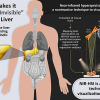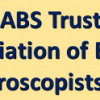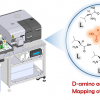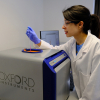Spectroscopy News
NIR-HSI is non-invasive and can be used to quantify fat content in liver aiding medical research and the diagnosis of liver diseases.
Applications are invited for two awards administered by the ABS Trust.
Inspired by the eyes of mantis shrimp, researchers have developed a new kind of optical sensor that is small enough to fit on a smartphone but is capable of hyperspectral and polarimetric imaging.
KPM Analytics has partnered with AB Vista to provide their NIR analysis solutions with the Aunir calibration database.
FT-IR spectroscopy has been shown to be able to detect individuals by their blood profile which lays the basis for rapid diagnosis of many diseases.
Wasatch Photonics achieves ISO 9001:2015 certification for their volume phase holographic diffraction gratings facility.
Thermo Fisher Scientific is to collaborate with Protein Metrics to optimise mass spectrometry data analysis for biopharmaceutical and proteomics applications.
A new NALDI-TOF-MS technique detects minute particles of plastics in snow, rain and even soil.
Researchers at the University of Surrey have found that LC-MS and PLS of non-invasive skin swab samples may be enough to detect COVID-19.
Scientists have succeeded for the first time in the direct spectroscopic detection of the binding of the “Parkinson protein” α-synuclein to lipid membranes in the cell.
Using time-resolved X-ray photoemission spectroscopy, scientists are for the first time analysing at the femtosecond scale the processes in a model system for organic solar cells.
HORIBA Scientific has presented Dr Luca Lanzano with the annual Young Fluorescence Investigator Award at the virtual Biophysical Society virtual event.
Researchers from Chalmers University of Technology have developed a microcomb design with up to ten times higher net conversion efficiency.
Mass spectrometry can be used to identify Parkinson’s based on compounds found on the surface of skin. The findings offer hope that a pioneering new test could be developed to diagnose the degenerative condition through a simple skin swab.
trinamiX and Viavi Solutions have announced a joint development agreement to build an NIR spectrometer module for integration into consumer devices.
A research team from the Zhejiang University Institute of Translational Medicine has developed an active SERS probe that can be used for SERS imaging of tumours.
Scientists at have Ehime University have developed a multidimensional vibrational circular dichroism system using a quantum cascade laser.
Oxford Instruments, Oxford University and Henry Royce Institute have agreed an R&D collaboration to use benchtop NMR to develop new methods to monitor reactions in battery cells.
Researchers at Kanazawa University have successfully tested a sensor for measuring hydrogen peroxide concentrations near cell membranes. The sensor has the potential to become a tool for new cancer therapies.
An NMR-based serum test has been shown to assess kidney function and provides for a more precise estimation of glomerular filtration rate.

















